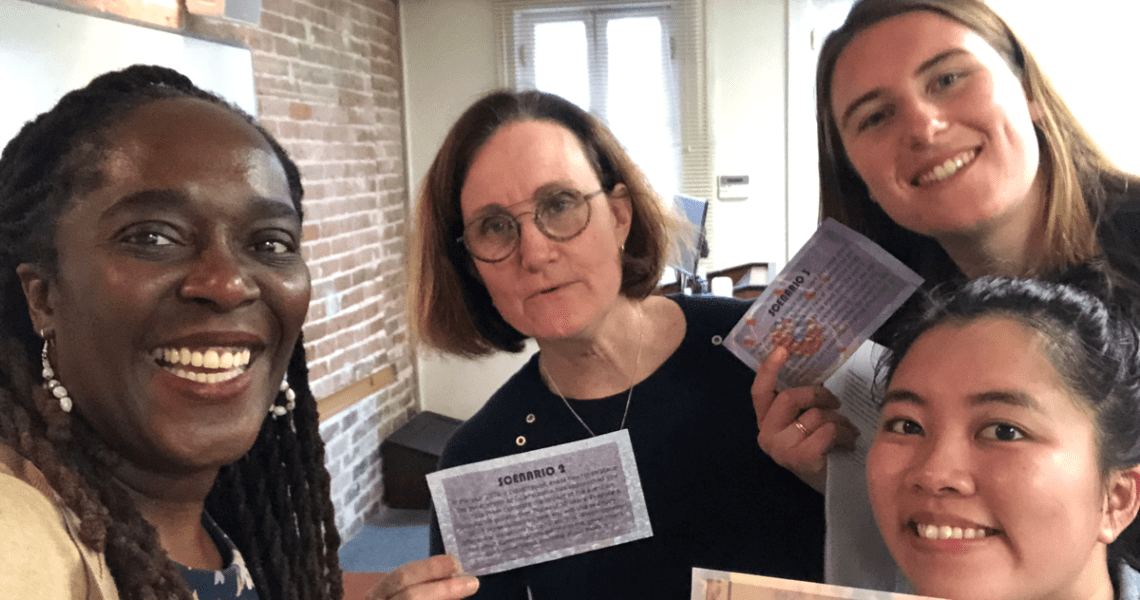
Design thinking in Applied Math Education
A college student sits in an Applied Math class waiting for the lecture to begin. As the professor introduces the three guests who were expected to talk about design thinking, the lights flicker.
“OMG what’s going on,” cries one of the guests.
“We have been transported to the year 2075!” shouts one of the other guests.
The third guest declares: “A catastrophic event has happened, and you have been given the job of helping the government of Tulanelandia predict the future. Your only tool? Ordinary differential equations!”
Thus began a math class using design thinking taught by Dr. Marie Dahleh, Associate Dean for Strategic Innovation and Program Development at Tulane University and Senior Professor of Practice in Mathematics at Tulane’s School of Science & Engineering, with guest participation from Dr. Lesley-Ann Noel, Associate Director of Design Thinking for Social Impact and Design Thinking student fellows, Tran Nguyen-Phuong and Delaney Connor.
Design thinking and math education
Dr. Dahleh was inspired to bring design thinking to her work by her participation in Dr. Noel’s design thinking focused faculty learning community sponsored by Tulane’s Center for Engaged Learning and Teaching. This community of faculty members works together to spread design thinking to classrooms and research projects across Tulane’s campus. The diverse disciplines represented in the faculty cohort demonstrate design thinking’s ability to cross boundaries in academia.
“This was a pretty exciting collaboration for me,” explained Dr. Noel. “I wasn’t very good at absorbing the abstract elements of math at middle and high school, but I enjoyed it when I could see it applied in a real context during undergrad and my masters. So I enjoyed the challenge of thinking of how we could use a design thinking approach in Math.”
Dr. Noel and Dr. Dahleh worked with the Taylor Center’s Design Thinking student fellows to design this workshop. Tran Nguyen-Phuong ‘22, a 2019-2020 fellow, writes, “As someone extremely passionate about education and learning, it was disappointing for me to observe the amounts of creativity, energy, and “fun” slowly evaporate as I transitioned into upper-level courses… Reintroducing play and exploration back into learning were my top priorities.”
Student opinions on ODEs before the workshop
Ordinary Differential Equations are integral to the social and physical sciences in calculating everything from population growth to radioactive decay to celestial mechanics to the stock market. However, in a class survey, many students expressed indifference towards these equations and a limited understanding of their power.
Dr. Noel and Dr. Dahleh co-facilitated this class to support the students in growing their creativity, confidence, and skill in applying Ordinary Differential Equations in real-world scenarios. Although students in the class were familiar with ODE’s prior to the class, only a few were familiar with design thinking. Together, they hoped to show that how cultivating design thinking mindsets can be immensely useful in applied math. Dr. Dahleh and Dr. Noel chose March 2 for the class since as they thought the student might have still been ‘restless’ post-Mardi Gras.
Workshop Instructions
Students worked in groups to use differential equations to make predictions on the five different scenarios to predict the future of Tulanelandia in 2075. At the end of the class period, each group presented to the government (Taylor Center Design Thinking fellows who were not familiar with ODEs) on how the equations could help them.
The Scenarios were:
- Calculate the impact of the event on global warming over the next 30 years.
- Calculate the impact of the event on population growth over the next 30 years.
- Calculate the rate of radioactive decay that has been caused by the event over the next 3 months.
- Calculate the rate of the spread of infectious diseases that have been caused by the event over the next 3 months.
- Calculate the fastest way to remove pollution from the disaster struck lake Pontchartrain over the next 3 weeks.
The students were given common examples of Ordinary Differential Equations (ODE) used to predict and model the future such as” the SIR model (Susceptible, infected, recovered), Energy Balance Model, Population growth , Mixture problems, Radioactive Decay, and Newton’s law of heating/ cooling.
Student Experiences
Students were hesitant about the activity at first. However, they quickly warmed up and the room filled with conversation. The design thinking team purposely avoided jargon or technical terms or concepts, encouraging creativity and spontaneity instead.
When thinking through their scenarios, each group was asked to consider the stakeholders involved, and students contextualized the circumstances of their scenarios with real-world people.
- Students in the sickness/ infection scenario group talked about how their stakeholders were patients, health professionals, transportation organizations (i.e. airports, ports), etc. They were able to draw inspiration from the present Coronavirus global health problem to model their responses.
- Once encouraged to approach the formulas with creativity, students began to ideate new methods for using the formula to solve the challenge. Some students even imagined ways the formulas could be adapted or changed to encompass/address new aspects of their challenges.
- Several groups came up with innovative, out of the box solutions that disregarded real-world constraints. One group suggested that the city drain Lake Ponchartrain and remove the aquatic life in order to filter the pollution. Afterward, they would reintroduce aquatic life back into clean water.
- When challenged to explain the complex ordinary differential equations to the Tulanelandia Government, aka the Taylor Design Thinking team without Math training, students exercised creative communication skills to modify and simplify the language of their explanations.
Student Reflections
Through exploration, play, and collaborative problem solving, students developed an understanding of ODE’s that went beyond a textbook or lecture. Here are a few of their reflections:
“I used to think ODEs weren’t super related to real life situations outside of population growth.
Now, I think they have a lot more application to the real world including global climate change.”- Miles Huber“I used to think ODEs were really confusing.
Now I think ODEs are easier to understand when looking at real world examples” – Sophie Natale-Short“I used to think ODE’s have no application in the real world.
Now I think that ODE’s are very useful in predicting future behavior.” – Rachel Taylor“I used to think ODEs had little to no application in real life to non-mathematicians.
Now I think that anyone can understand how ODEs can be used to solve real world applications, even if they can’t solve it.” – Matt Camella“I used to think that describing differential equations to people who didn’t understand them was difficult.
Now after presenting I think it’s easy!” -Calla Hindems
Looking to the Future
Merging mathematics and design thinking helped the students experience the ways that math can help implement positive social change on a macro-scale. “I left the class really energized by the student feedback and the whole experience of creating these scenarios to help the students understand how to apply the Math,” stated Dr. Noel. “I already started to imagine us really doing modeling for the city in other design-thinking math classes to show the city’s administration how Tulane students could use ordinary differential equations to predict change.”
Dr. Dahleh also remarked on how surprised she was at the level of engagement of all of the students, even students who traditionally might not have been excited by the content gave passionate presentations to the government of Tulanelandia. These presentations demonstrated their understanding of the concepts.
Dr. Noel and Dr. Dahleh look forward to collaborating on other Math and Design Thinking experiments in the future.
This project is made possible with the support of Tulane’s Center for Engaged Teaching and Learning.
